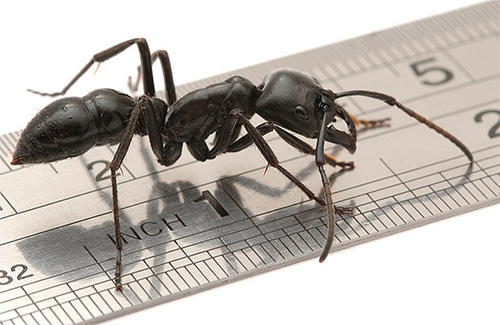
The answer to the question of how many legs an ant has is quite simple: any ant has 6 legs. Moreover, regardless of the type, size, color and habitat - this is the main difference between any ant and its distant relatives - ticks, spiders and crustaceans. In general, in all ants in the adult stage, all six legs are clearly visible and distinguishable, and therefore it is relatively easy to count them.
Each pair of ant legs is located on a separate part of the chest. These segments have different sizes and proportions in different species of ants and even in individual castes of the same species, but in general the location of the legs is common to all ants.

The front legs of ants are located on the prothorax. On these paws, ants have a special device, similar to a small brush, with which the insect can clean the antennae and other paws.
On the hind legs of the ant there are spurs that perform different functions. Most often, they are used by soldier ants to participate in battles with other ants.
Due to the special structure of their legs, ants receive many useful abilities due to them.
How do ants stay on steep surfaces?
Surfaces of almost any degree of smoothness and sheerness are not an obstacle for ants. The smaller the ant, the smoother the surface it can run. For example, the domestic pharaoh ant calmly moves across the glass, which, for example, a black cockroach cannot do.

In such acrobatics, ants are helped by tiny notches on their paws, with which they can quite successfully cling to ledges that are visible only under a microscope. Of course, tree trunks and stone surfaces in nature are like a convenient ladder for them.
It is interesting
Some ants from the chaise family can run at a speed of about 4 km / h, being one of the fastest running insects in general (today the running record is registered for jumping beetles and Madagascar cockroaches). The paws are the only salvation for these ants that live in some of the most extreme biotopes in the world in general - in the sandy and clay deserts of Africa, Asia and America. These ants can withstand air temperatures up to 50 ° C, but if under such conditions the ant lingers in the sun and does not reach the anthill in time, it will simply fry.
In addition, thanks to their legs, some ants can swim. This, for example, distinguishes the Australian bulldog ants, insects that are unique in many of their qualities. They are able to easily swim across water barriers 15 cm wide (for example, small puddles).
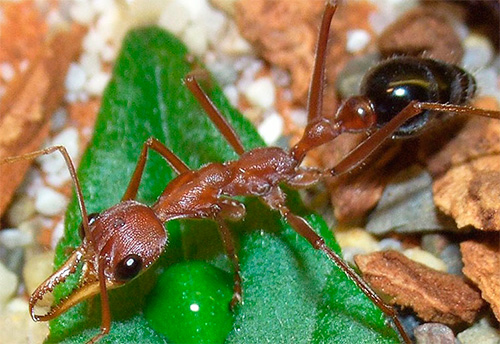
It is interesting
Ants bulldogs also know how to make big jumps - up to 50 cm in length. Only they do this not with the help of their paws, but by pushing off the ground with their jaws.
6 legs as a hallmark of ants
It is by the number of legs that ants differ from most other arthropods.So, some tourists who are poorly versed in biology may confuse ants with very small mites or spiders. All arachnids (which include ticks) have eight legs, and only by counting how many legs an “ant” has, one can definitely say whether it is really an ant.
In addition to spiders and ticks, there are no more arthropods in the fauna of our country, with which ants can be confused. But some beetles very skillfully imitate the shape of the body of ants in order to penetrate their anthills and live there. Such beetles are rarely seen, and without special knowledge, distinguishing them from ants can be very problematic.

On a note
But to distinguish the uterus of an ant from a working individual is quite simple: the uterus is much larger and more massive than worker ants, while they also have 6 legs.
Do ants use their paws to run?
With their legs, ants can perform a large number of operations. It is thanks to the strength of the paws and the ability to place them wider than the body itself that the ant can easily lift above itself and carry a load weighing 50 times its own.
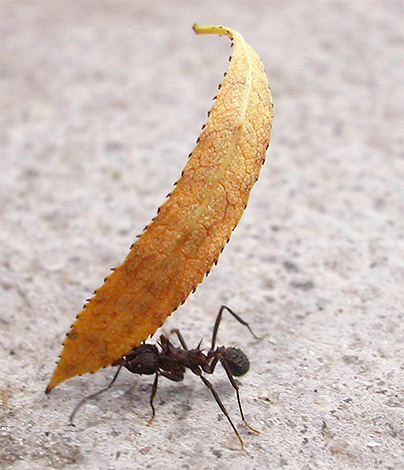
On a note
From a purely physiological point of view, there is nothing extraordinary in such superpowers of ants. With a decrease in the size of the body of any living being, the cross section of the muscles of its body decreases disproportionately. That is why, compared to its body, this tiny insect lifts a weight that would turn into 3 tons for a person. The ratio of muscle mass to the body mass of the ant itself is much greater than that of a human.
Desert ants use their feet to measure distance.This is a kind of navigational tool for them: the ant remembers how many steps it has taken after each turn, and on the way back it corrects for exactly this angle and for the same number of steps. If the length of the legs is changed (which the experimenters did when studying this phenomenon), the ant will either miss the target or, conversely, run across it.
And weaver ants, widely known for their skill in making nests from leaves, use their legs to pull the leaves together. Several ants (sometimes several dozen) grab the edge of one leaf with their jaws, and the edge of another with their paws, after which they press the edges one against the other, and other ants fasten the leaves with a secret secreted by the larvae. This is how a very convenient suspended nest for the whole colony is obtained, the living “skeleton” of which for the first few hours are working individuals.
Glands on the legs as a tool for orientation
Ants also use their legs to transmit scent signals. Scientists have discovered glands on the legs of ants that secrete strong-smelling pheromones. Ants leave these substances as marks on different objects in the course of their movement, making the trail more visible to other individuals.

The more ants run along such a path, the more marks remain on it, the more attractive it is for other individuals. Accordingly, the most visited paths look like comfortable highways to ants, while newly marked routes are comparable to a barely traveled path in the forest.
It is because of errors in the placement of such marks that the famous ant circles happen: if an ant accidentally runs in a circle and closes its own path with a fresher trail, obeying instinct, it then continues to run in a circle. Several of his brothers can connect to it, and when the number of ants exceeds several hundred, such a circle can become a real disaster for the family - the ants in it can run until they are completely exhausted. However, such a circle can arise only in the absence of noticeable external landmarks, when ants are forced to use only their scent trails for navigation.

Therefore, the next time you see an ant, take a closer look at its paws. These thin and inconspicuous at first glance organs help little hard workers to create real miracles!

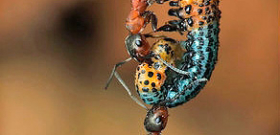

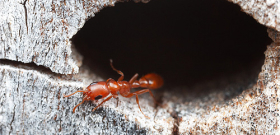
Do ants grow legs over time? And what will happen to him if he loses at least one?
No. Ants' legs do not regenerate. The ant is a one-time individual, with severe damage it quickly dies, no one cares about the disabled person, and sometimes other ants even kill. A high reproduction rate and a large number of colonies neutralize the value of an individual.
How is an ant's paw arranged? What makes her move? Muscles? How and where are they fixed in each joint? In my opinion, the movements of the paws are more complicated than just bending inward. So there must be some muscle there. Is the paw itself hollow? Where can you get more information about this? Questions from the engineer. I do robotics. Perhaps I can repeat the ant for household needs.
Be, after that such bad sensations, as in the lessons of the world around.